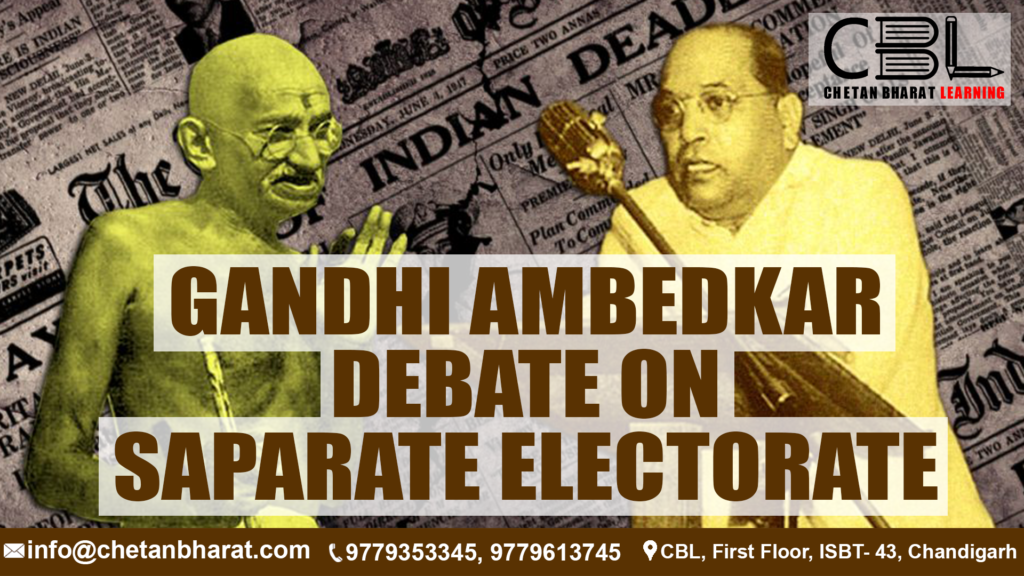
Important for UPSC, State PCS
For Prelims: Modern India history , Ambedkar and Gandhi
For Mains: Modern India history , Ambedkar and Gandhi
Mains: General Studies Paper 1 and 2
Why in News?
On September 20, 1932, Mahatma Gandhi began a fast unto death in Pune’s Yerawada Jail in protest against the award of separate electorates for Scheduled Castes
Background
The foundation for separate electorates in British India was laid in the Morley-Minto Reforms of 1909. These reforms granted separate electorates for Muslims, allowing them to elect representatives exclusively from their own community. Over time, the concept was extended to other groups, such as women, Sikhs, and other marginalised classes.
In 1932, British Prime Minister Ramsay MacDonald introduced the Communal Award, which proposed separate electorates for different social communities and religions in India. This system of separate electorates allowed specific groups to elect their own representatives.
The Poona pact
Instead of separate electorates, the Untouchables would have reserved seats in general constituencies, with the number of seats in provincial legislatures increasing from 78 to 148
The origins of the Poona Pact are tied to the Communal Award of August 1932, which sought to allocate separate electorates for various minority groups, including Muslims, Sikhs, Indian Christians, and the Depressed Classes.
As part of this Award, 71 seats in the central legislature were reserved specifically for the Depressed Classes.
Gandhi, in Yerawada Jail, opposed separate electorates for the Depressed Classes, and began a fast unto death in protest.
On September 24, 1932, Ambedkar met Gandhi in jail, and they signed the Poona Pact.
Gandhi vs Ambedkar on Caste
- Mahatma Gandhi views on caste system;
- He opposed untouchability, calling Untouchables “Harijans” (Children of God). Despite this, Gandhi never fully rejected the caste system itself.
- He believed that caste could be reformed from within, by eliminating untouchability and fostering social harmony, while still preserving the traditional varna (caste) system.
- Gandhi saw caste as a social organization that had a place in Hinduism and thought reforms within it could help uplift marginalized groups.
- Dr. B.R. Ambedkar:
- In contrast, Dr. B.R. Ambedkar took a much more radical stance. Ambedkar viewed caste as the root cause of untouchability and firmly believed that true social change could only occur if the caste system itself was abolished.
- He argued that caste had deep roots in the authority of Hindu scriptures (shastras), which legitimised and perpetuated the caste hierarchy. For him, only by rejecting the authority of these scriptures could the system of caste, and consequently untouchability, be dismantled.
- According to Ambedkar, meaningful reform required not just calling the untouchables by a different name like “Harijan” but a direct challenge to the religious and social foundations of caste. In 1932, during the Round Table Conference, he advocated for separate electorates for the Depressed Classes (later called Scheduled Castes).
Concept of Separate Electorates with Double Vote
The proposal for separate electorates involved a double vote system. For example, in a constituency like Madras, where there is a separate electorate for the Scheduled Caste (SC) community, SC voters would cast two votes:
- First Vote: Scheduled Caste (SC) voters would elect a representative exclusively from their community. This representative would be an SC member, and only SC voters would participate in this election.
- Second Vote: SC voters would also participate in the general electorate. Here, they could vote for any candidate standing in the general election, alongside voters from other communities.
Concluding remarks
- Gandhi sought to reform the caste system by eliminating untouchability and preserving social harmony, Ambedkar called for the complete rejection of the caste system, seeing it as inherently unjust and rooted in religious authority.
- Gandhi’s approach was towards reform within society opposed to the radical approach followed by Ambedkar.
CBL- Practice Questions for Prelims
What did the Poona Pact primarily establish regarding the representation of Scheduled Castes?
A) Separate electorates for Scheduled Castes
B) A joint electorate with reserved seats
C) Complete integration of Scheduled Castes into the general electorate
D) Electoral representation only in state assemblies
Answer: B) A joint electorate with reserved seats
CBL – Mains Practice Question
Evaluate Mahatma Gandhi’s vision of social unity in contrast to Dr. B.R. Ambedkar’s demand for separate electorates. How do these differing visions continue to influence contemporary discussions on caste and representation in India ?




Leave a Reply
You must be logged in to post a comment.